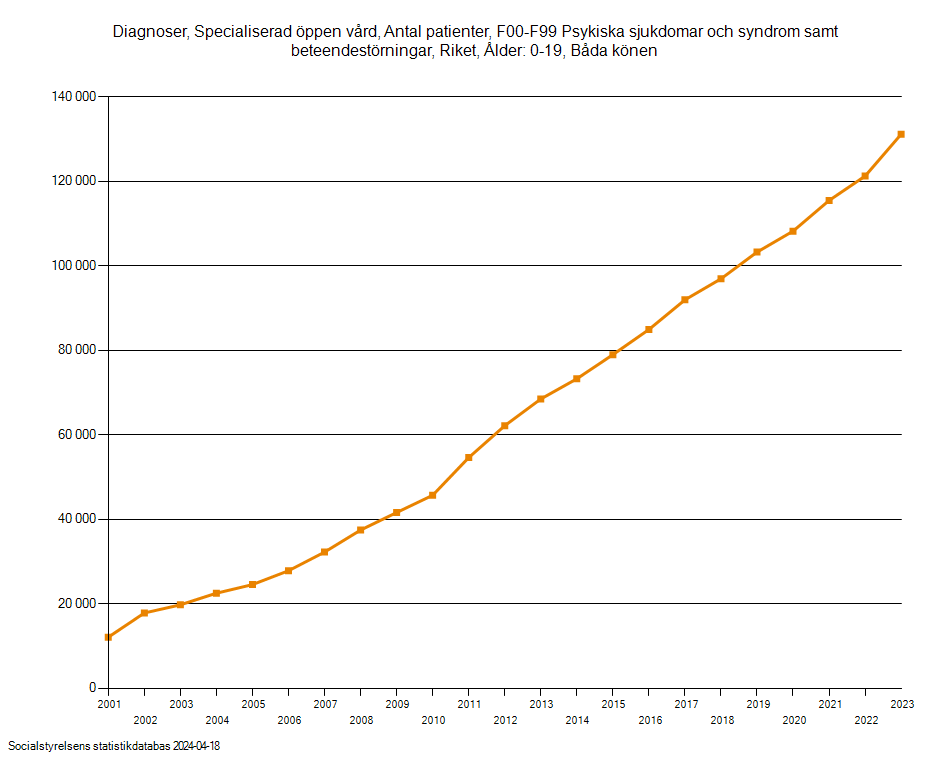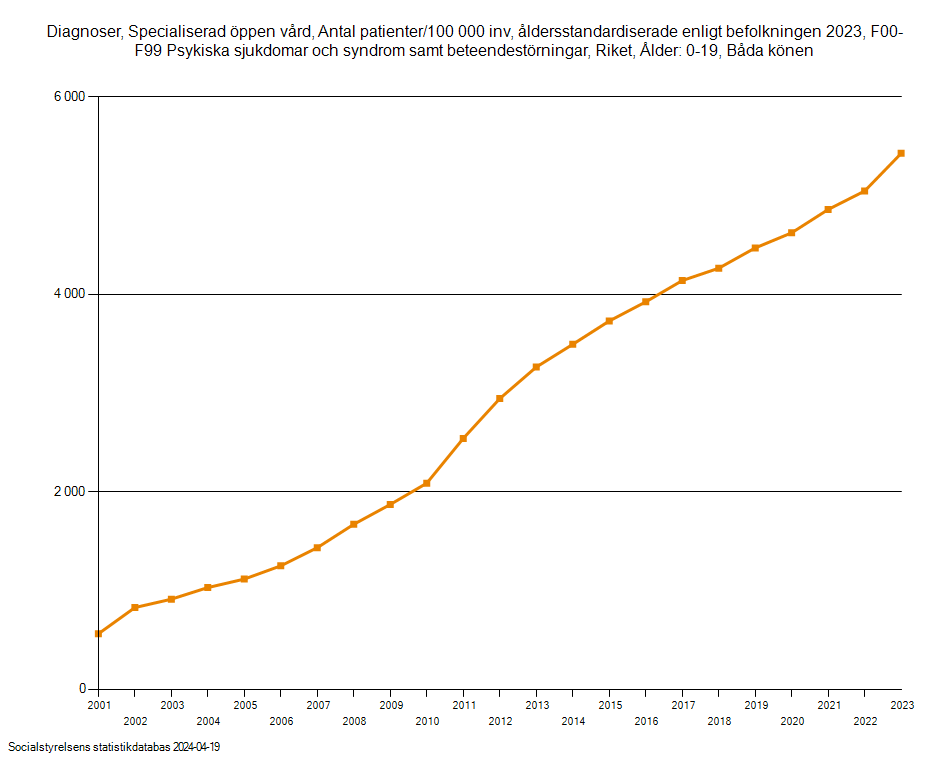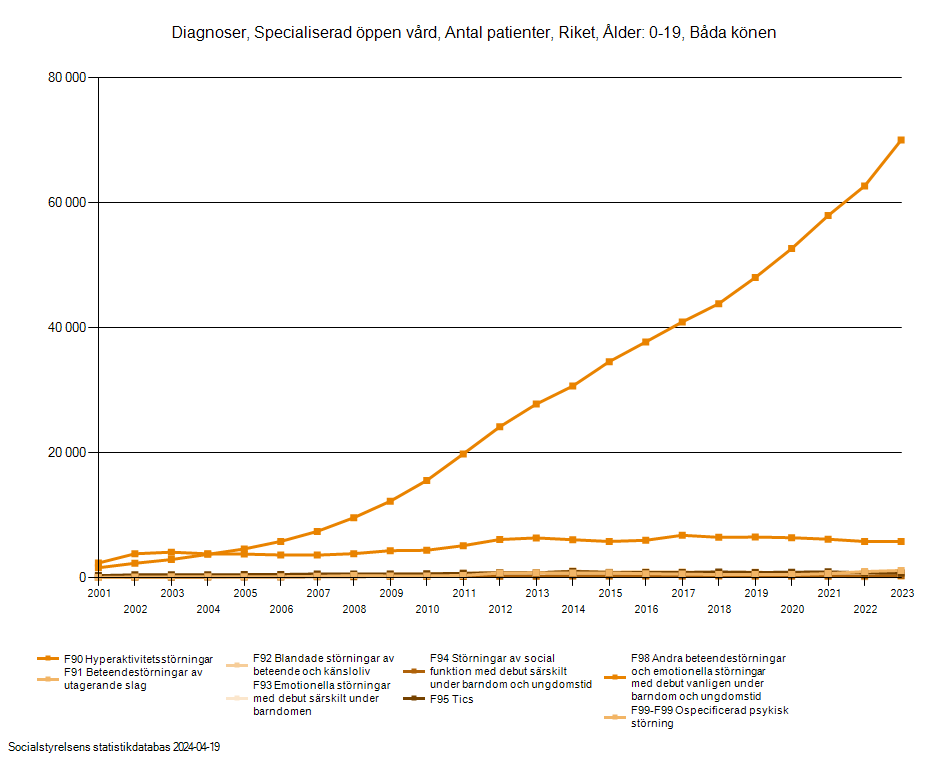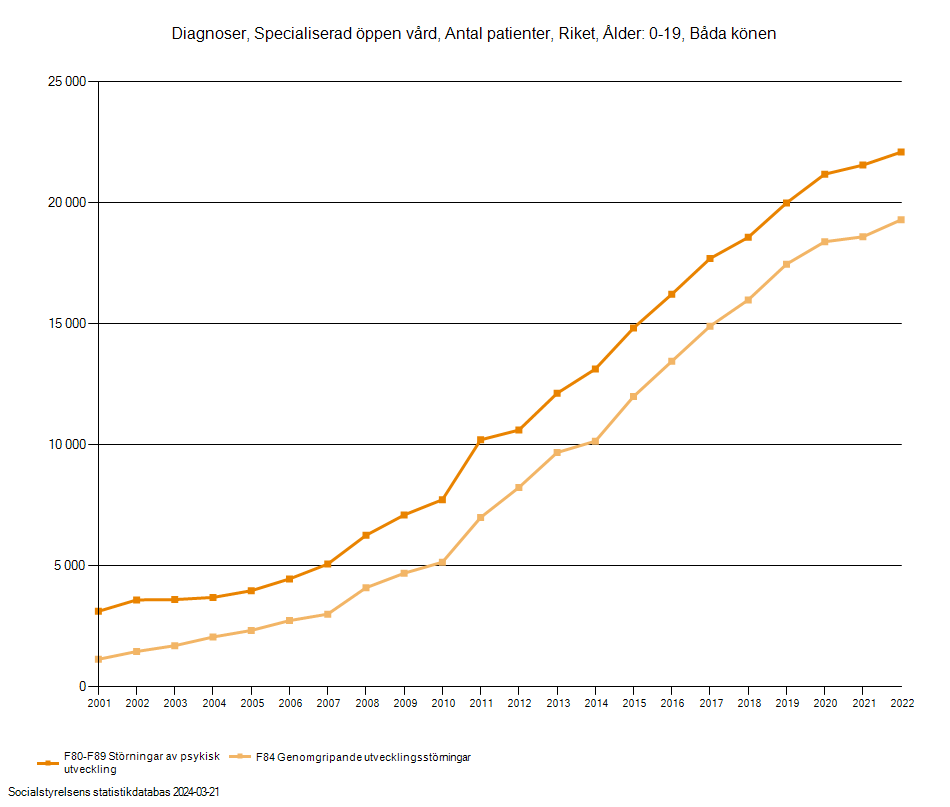Behavioural disorders and mental illnesses on the rise among Swedish children
The number of Swedish children with behavioural disorders or mental illness has increased sharply over the past 20 years, according to National Board of Health and Welfare statistics. More than six times as many children and young people aged 0-19 had one of these diagnoses when visiting specialised outpatient care in 2023, compared to 20 years ago. Research has shown that exposure to radiation from wireless technologies damages the brain and causes behavioural changes.
Originally published by the Strålskyddsstiftelsen on 19 April, 2024
The Swedish Radiation Protection Foundation has reviewed the latest statistics from the National Board of Health and Welfare regarding the number of children in specialised outpatient care who each year received one of the diagnoses that fall within the category of behavioural disorders or mental illnesses or syndromes. We have previously reported that the number of children aged 0-19 years diagnosed with sleep disorders has increased sharply.
The chart below is taken from the National Board of Health and Welfare. It shows the number of children aged 0-19 years who visited specialised outpatient care each year between 2001 and 2023 and who, according to doctors, had behavioural disorders or mental illness. In 2023, just over 131 000 children with one of these diagnoses visited outpatient services. In 2003, the number was just under 20 000.

The graph below shows the number of children aged 0-19 with behavioural disorders or mental illnesses/syndromes who visited specialised outpatient care each year between 2001 and 2023 per 100 000 inhabitants, standardised by age. Source: National Board of Health and Welfare.

The individual diagnoses that dominate within this diagnostic group (F0-F98) are F90 Hyperactivity disorder, which increased from just over 2,800 in 2003 to just over 70,000 children aged 0-19 in 2023.

Another diagnosis within the diagnostic group that has increased a lot is F84 Pervasive developmental disorder. The diagram below shows that the number of children in specialised outpatient care each year with this diagnosis has increased from just under 1,700 in 2023 to just over 21,000 in 2023.

Other diagnoses that have increased are F40-F48 Neurotic, stress-related and somatoform syndromes, from just over 2,500 children in 2003 to just over 20,000 in 2023. Within this group, the diagnosis F41 “Other anxiety disorders” dominates, increasing from just over 900 children in 2003 to just over 14,000 in 2023.
Radiation from wireless technology harmful to the brain
Research has repeatedly and extensively shown that radiation from wireless technology damages the brain and mental health. During the same period that an increasing number of children in Sweden suffer from mental illnesses or behavioural disorders, children’s exposure to radiation from wireless technology has increased massively, according to the National Board of Health and Welfare’s statistics. This is through both foetal and postnatal exposure as a result of the increasing use of mobile phones, wireless data networks, wirelessly connected computers and the growing number of 4G and 5G base stations that emit ever stronger radiation.
For more than 50 years, scientists have described how the brain and central nervous system are particularly affected by this type of radiation. In 2014, an international expert report (Bioinitiative report) related that a total of 234 studies published between 2007 and 2014 showed that radiation from wireless technologies and low-frequency fields negatively affect the central nervous system. Repeated studies show that nerve cells die, memory is impaired and behaviour is affected.
Children and adolescents and the unborn foetus are particularly at risk, as noted by the French government report ANSES in 2016. Children absorb more radiation and their nervous systems are still developing. The nervous system develops throughout adolescence. Research has shown that when foetuses are exposed in the womb, the brain can suffer permanent damage and behavioural disorders.
Causes behavioural disorders, hyperactivity
In 2012, US researchers showed that prenatal exposure leads to permanent brain damage, impaired memory and hyperactive ADHD-like behaviour. It is precisely the hyperactivity diagnosis F90 that has increased the most among children over the past 20 years, according to the National Board of Health and Welfare statistics above.
Furthermore, in 2018, researchers demonstrated in animal experiments that WiFi-like radiation causes behavioural changes and an increase in the presence of a marker for cell death in the brain (caspase 3). The researchers concluded that the study clearly shows that the radiation leads to harmful effects on the brain leading to impaired learning and memory and altered anxiety-like behaviour. In 2015, researchers showed that long-term exposure to low levels of WiFi changed molecules in the brain that have been linked to Alzheimer’s, cancer, diabetes and more. The researchers concluded that long-term exposure to 2.4 GHz can cause adverse health effects such as neurodegenerative diseases.
In 2008, a major Danish study reported on the relationship between mothers’ use of mobile phones and children’s behaviour. The study involved over 13 000 Danish children. Children exposed both during the foetal period and after birth had a higher prevalence of behavioural disorders, in the form of hyperactivity and emotional disturbance, at the age of 7.
Three studies on the link between mothers’ use of mobile phones and children’s cognitive ability showed in 2018 that children of mothers with the highest mobile phone use had poorer cognitive ability at age 5.
Impaired memory and learning
Below is a list of examples of research from one of our factsheets that showed harmful effects on memory and learning, mainly in animal experiments up to 2018. This has been known for several years, but the responsible authorities and the government have turned a blind eye to the accumulated evidence:
- Young people aged 15-19 who use mobile phones have impaired memory function. Study of 670 young mobile phone users in Switzerland. 2018
- Animal experiments show that mobile phone radiation (GSM 900) impairs memory. Rats were exposed for 4 weeks. 2018
- Animal experiments show that mobile phone radiation causes harmful changes in brain cell gene expression that may explain, among other things, memory impairment in previous animal experiments. 2018
- Rats exposed to 2.45 GHz WiFi radiation show behavioural changes and increased levels of a brain cell death marker (caspase 3) and oxidative stress. The 2.45 GHz frequency produced a greater effect than 1.8 GHz and 900 MHz. The rats were exposed for four hours a day for 45 days. The researchers conclude that the study clearly shows that the radiation leads to harmful effects on the brain, leading to impaired learning and memory and altered, anxiety-like behaviour. 2018.
- Animal experiments show that 7.5 kHz magnetic fields affect learning and memory likely via an inflammatory response in the hippocampus. 2017
- Exposure to microwave radiation at 10 GHz damages the brain in animal experiments including impaired memory and learning ability, oxidative stress. 2017
- Use of mobile phones has significant negative impact on working memory among exposed humans in provocation study. Effects observed already after 5 minutes. Largest impact on people aged over 60 years and for people with cognitive problems. 2017
- GSM 900 and 1800 mobile phone radiation damages cells in the brain’s hippocampus (memory etc.) in animal experiments. 2016
- Elevated levels of low-frequency magnetic fields cause memory impairment. 2016
- The greater the use of mobile phones or exposure to mobile phone radiation, the worse the memory of young people. Study from Switzerland. 2015
- Exposure to mobile phone radiation at low levels, one hour a day for a long time (eight weeks in this study of mice) affects genes. May cause impaired learning and memory by affecting proteins and metabolic processes linked to brain function and disease. 2015
- Chronic exposure to mobile phone radiation 1800 MHz leads to reduced levels of neurotransmitters (serotonin, dopamine, etc.) which are important for memory, learning and mental health. 2015
- Mobile phone radiation affects the production of serotonin, which is important for memory, learning and mental health. 2015
- Mice exposed to mobile phone radiation, three hours a day for 28 days, suffer memory impairment and the protective blood-brain barrier becomes permeable. Confirms previous studies that also showed effects on the blood-brain barrier and memory. 2015
- Rats exposed to mobile phone radiation suffer harmful changes in brain cells, oxidative stress and impaired memory and learning. 2014
- Mice exposed to microwave radiation suffer memory impairment. GABA, a neurotransmitter in the brain that is important for memory and other functions, is affected. 2014
- Low-frequency electromagnetic fields affect brain functions such as memory and learning. 2014
- Mice exposed to mobile phone radiation during foetal life have impaired memory and
learning ability. 2014 - Exposure to GSM 1800 mobile phone radiation for up to 120 minutes per day for 30 days at levels below the applicable limit led to impaired memory and learning in mice. Selenium supplementation had a protective effect. 2014
- Exposure to low-frequency electromagnetic fields causes changes in the brain that may explain impaired learning and memory. 2014
- Aluminium and low-frequency electromagnetic fields have the same negative impact on the brain through impaired memory and reduced defence against oxidative stress in animal experiments. 2013
- Mobile phone radiation far below current limits alters neurotransmitters in the brains of mice. May explain reported effects on memory, learning and brain stress. 2013.
- Mobile phone radiation causes DNA damage in the brains of mice. May ultimately lead to neurodegenerative diseases and cancer. 23 July 2013
- Significantly increased incidence of insomnia, headaches, dizziness, malaise,
depression, memory disorders, increased irritability and nervousness among residents within 300 metres from mobile phone masts compared to those living further away. 2013 - Mobile phone radiation (GSM 1800) impairs memory in mice when exposed to mobile phone radiation for 90 minutes a day for up to 148 days at levels well below the applicable limit (0.11 W/kg). 2013
- Exposure to WiFi-like signals (2450 MHz) causes impaired glucose uptake in the brain which can lead to impaired memory and learning ability. 2012
- Rats exposed to mobile phone radiation for a short period of time (two hours) have effects on orientation and behaviour and changes indicative of oxidative stress. 2012
- Mobile phone radiation below the current limit causes memory impairment and brain damage in mice exposed for up to one month. 28 September 2012
- Mouse foetuses exposed to very low frequency electromagnetic fields with complex
composition suffer permanent brain damage that manifests itself in behavioural changes. 2012 - Mice exposed to electromagnetic radiation for a total of 200 hours at levels well below the applicable limit (3 μT) develop symptoms suggestive of depression/anxiety. In addition, levels of corticosterone, which is linked to stress and memory impairment, increased. 2012
- Ants have impaired orientation and memory after exposure to GSM radiation. 2012
- Low-frequency EMFs impair memory in mice. 2012
- Exposure to mobile phone radiation below the current limit during the foetal stage causes
behavioural disorders (ADHD) and memory impairment in mice. 2012 - Memory impairment, increased fatigue among effects observed in children 7-12 years old using mobile phones. 2011
- Mice exposed to mobile phones for eight hours a day for three weeks have increased levels of proteins in their brains that are linked to brain damage and memory impairment. 2010
- Mice exposed to a mobile phone for one hour a day for four weeks suffer memory loss and brain cell damage. 2010
- Mobile phone radiation impairs memory and cognitive ability in rats. 2009
- Young mice exposed to mobile phone radiation have reduced numbers of cells in the part of the brain important for memory (hippocampus). 2009
- Mobile phone radiation impairs memory in mice exposed for two hours a day for 55 weeks at power levels far below current limits. 2008
- WiFi like radiation 2.45 GHz impairs memory/orientation in exposed animals. 2000
- WiFi like radiation 2.45 GHz impairs memory and orientation in exposed rats. 1994
Previous articles on the rise of mental illness
In 2019, the life insurance company Skandia estimated that mental illness cost Swedish society around SEK 142 billion in 2010 and that this cost will amount to around SEK 345 billion in 2030. Despite the government and authorities investing SEK 10 billion in mental health, the measures have had no effect, we wrote in 2019, which is probably due to turning a blind eye to the elephant in the room – the increasing impact of radiation. The government’s national coordinator stated in 2019 that mental health was costing 200 billion a year and that the policies in place were “at best only achieving temporary positive effects for a small number of people and at worst creating incalculable systemic errors”.
In 2016, the Swedish Radiation Protection Foundation published a report on the link between increasing radiation and mental health.
The betrayal of children is enormous
Unfortunately, responsible authorities and politicians have continued to turn a blind eye to the extensive scientific evidence confirming health risks and the link with rampant illness. Instead, even more harmful radiation exposure has been allowed. Never before have children been exposed to such high levels of radiation on such a large scale as today. The effects that are now being observed in the form of increased behavioural disorders, sleeping difficulties and mental illness are unfortunately an expected effect of this veritable radiation bomb on children in Sweden today. Knowledge of the harmful effects has been available for many years.
– The betrayal of people in Sweden by the responsible authorities and politicians is enormous. For many years they have ignored known facts and misled people about what has long been known about the health risks.
The Swedish Radiation Protection Foundation reiterates the need for a crisis commission on the issue of the ever-increasing health risks of radiation and its consequences for public health and in particular the impact on children. Our authorities and the government must take an objective and impartial look at the health risks of radiation, listen to those who have been pointing out the risks for many years now, and work to seriously prevent mental illness and other illnesses caused by radiation.
Suggest a correction






